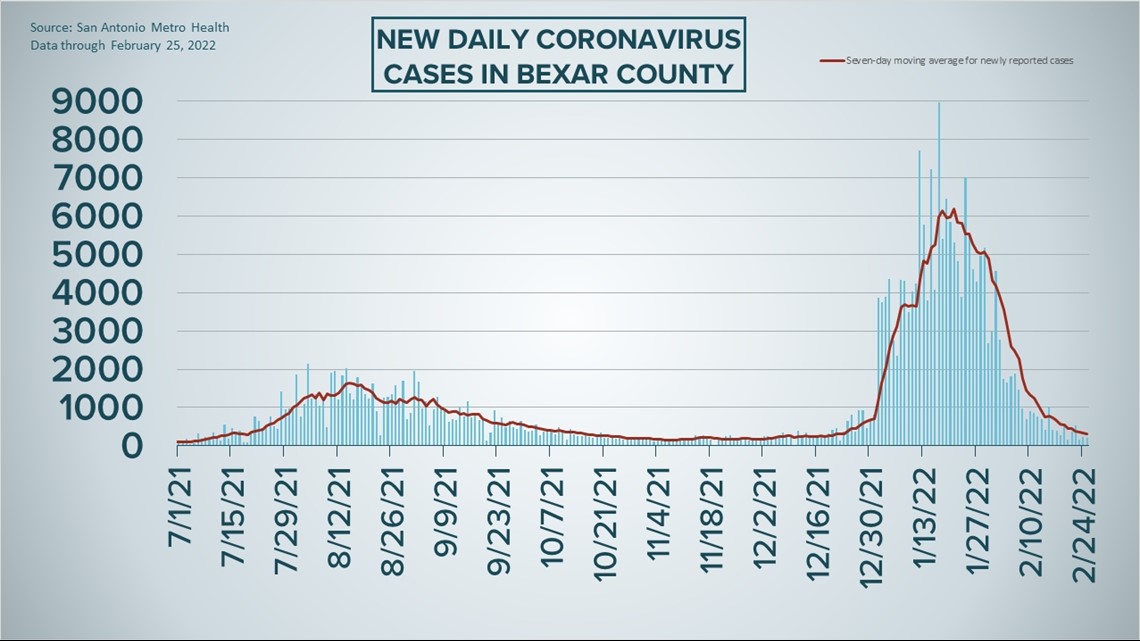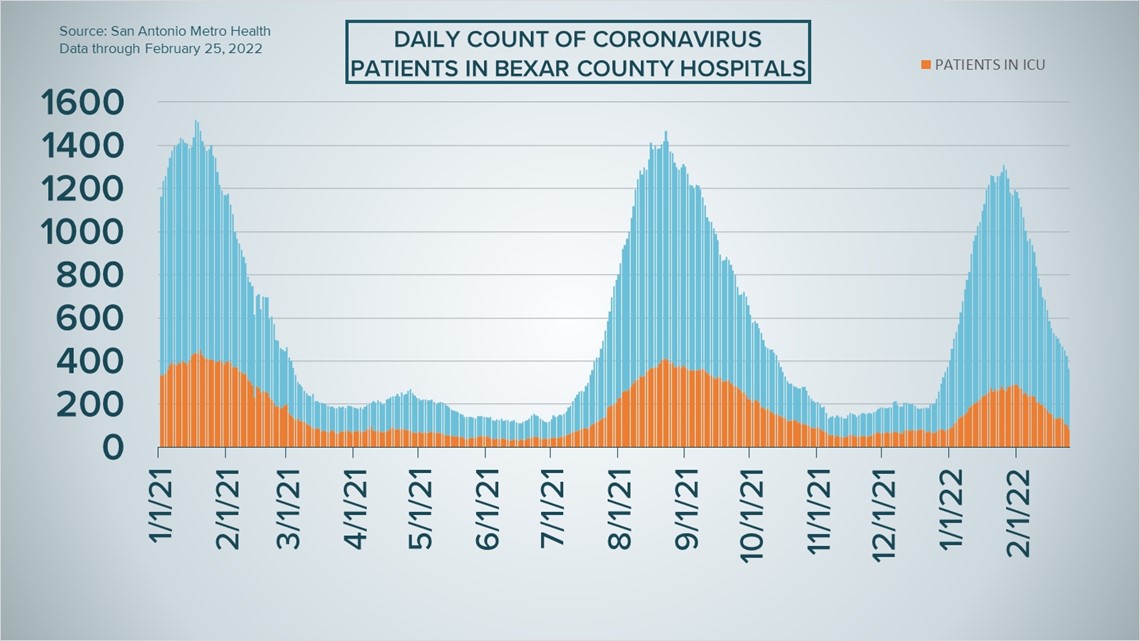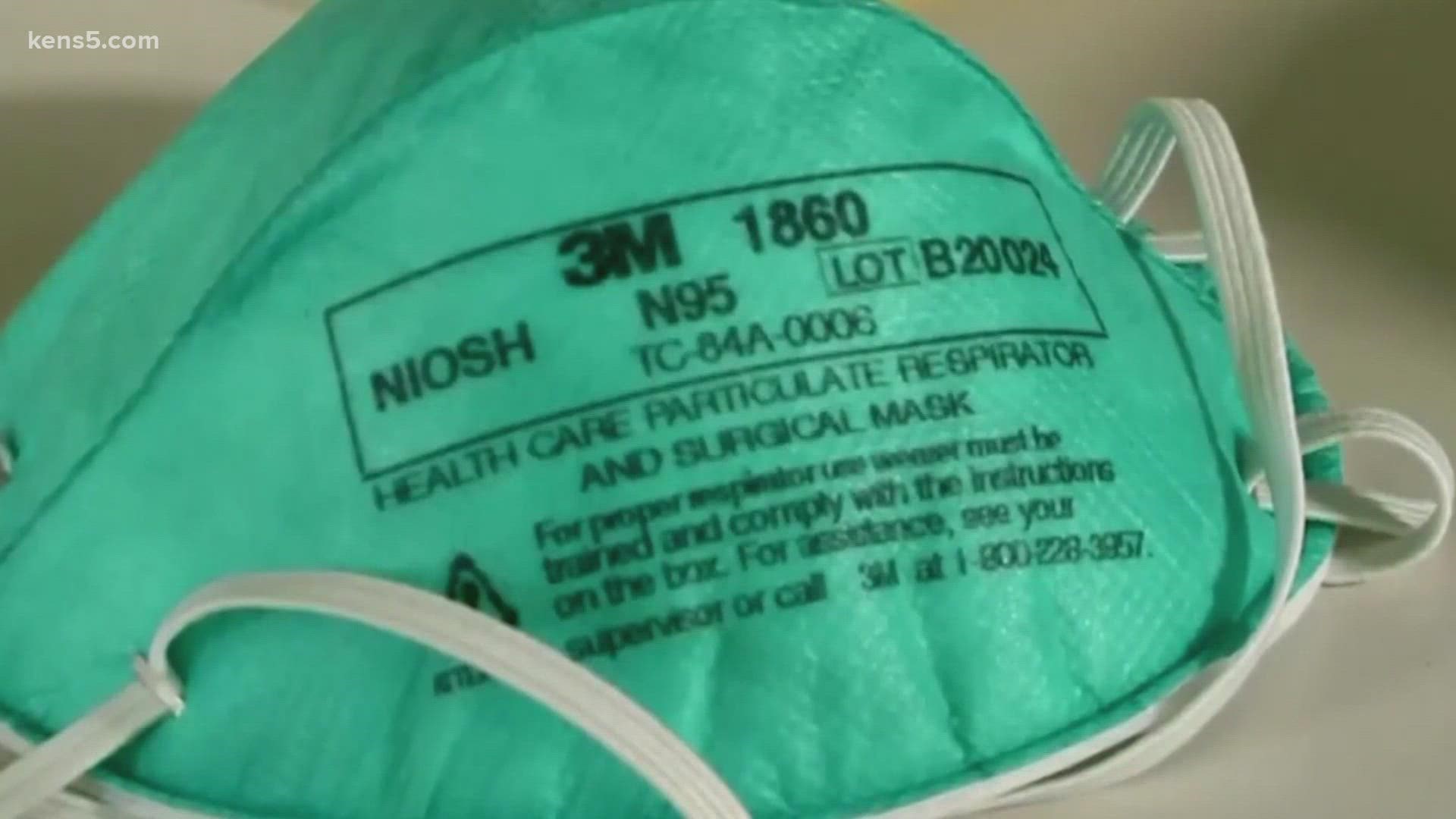SAN ANTONIO — The number of Bexar County COVID-19 hospitalizations saw its biggest decline in more than two weeks Friday, in the process dropping to a new record-low for 2022 as the pandemic eases following January's surge.
The week ended with 365 patients receiving treatment in local facilities for coronavirus symptoms, which is the fewest since Dec. 30 and down by 31% over the last week. Of those 365 hospitalizations, 84 are in intensive care and 41 are using ventilators; both those figures are also down from Thursday.
Meanwhile, Metro Health recorded 218 new infections on Friday, dropping the seven-day case average for a tenth consecutive day, this time to 314. Nearly 522,000 San Antonio-area residents have been diagnosed with the virus.
Meanwhile, five more residents have died from COVID-19 complications, bringing the community's death toll to 5,252.
The updates come as the Centers for Disease Control adjusts its mask-wearing guidelines based on the COVID-19 outlook county by county. Though the pandemic situation is improving in Bexar County, masks are still recommended in indoor settings as the virus continues to circulate.
How Bexar County is trending




Vaccine Progress in Bexar County
The following numbers are provided by San Antonio Metro Health. A full breakdown can be found here.
- 1.747 million eligible Bexar County residents have received at least one dose of the coronavirus vaccine as of Thursday, Feb. 24.
- 1.424 million eligible Bexar County residents are fully vaccinated as of Thursday, Feb. 24.
The CDC states that "when a high percentage of the community is immune to a disease (through vaccination and/or prior illness)," that community will have reached herd immunity, "making the spread of this disease from person to person unlikely."
The City of San Antonio breaks down the vaccination rates by zip code on Metro Health's Vaccination Statistics page.
Coronavirus in Texas
The total number of coronavirus cases in the state since the pandemic began grew by 5,860 on Thursday, according to the Texas Department of State Health Services. Texas did not provide updated numbers on Friday.
More than 6.533 million Texans have been diagnosed with COVID-19, while 83,121 Lone Star State residents have died from virus complications.
More details can be found on this page.
Coronavirus symptoms
The symptoms of coronavirus can be similar to the flu or a bad cold. Symptoms include fever or chills, cough, shortness of breath or difficulty breathing, fatigue, muscle or body aches, headache, new loss of taste or smell sore throat, congestion or runny nose, nausea or vomiting, and diarrhea, according to the Centers for Disease Control.
Most healthy people will have mild symptoms. A study of more than 72,000 patients by the Centers for Disease Control in China showed 80 percent of the cases there were mild.
But infections can cause pneumonia, severe acute respiratory syndrome, kidney failure, and even death, according to the World Health Organization. Older people with underlying health conditions are most at risk.
Experts determined there was consistent evidence these conditions increase a person's risk, regardless of age:
- Chronic kidney disease
- COPD (chronic obstructive pulmonary disease)
- Obesity (BMI of 30 or higher)
- Immunocompromised state (weakened immune system) from solid organ transplant
- Serious heart conditions, such as heart failure, coronary artery disease, or cardiomyopathies
- Sickle cell disease
- Type 2 diabetes
- The CDC believes symptoms may appear anywhere from two to 14 days after being exposed.
Human coronaviruses are usually spread...
- Between people who are in close contact with one another (within about 6 feet).
- Through respiratory droplets produced when an infected person coughs, sneezes or talks. These droplets can land in the mouths or noses of people who are nearby or possibly be inhaled into the lungs.
- Some recent studies have suggested that COVID-19 may be spread by people who are not showing symptoms.
Help stop the spread of coronavirus
- Stay home when you are sick.
- Eat and sleep separately from your family members
- Use different utensils and dishes
- Cover your cough or sneeze with your arm, not your hand.
- If you use a tissue, throw it in the trash.
Find a Testing Location
City officials recommend getting a COVID-19 test if you experience fever or chills, cough, shortness of breath or difficulty breathing, fatigue, muscle or body aches, headache, new loss of taste or smell, sore throat, congestion or runny nose, nausea or vomiting, or diarrhea.
Here's a Testing Sites Locator to help you find the testing location closest to you in San Antonio.
Latest Coronavirus Headlines
- Target eliminates face mask requirement for employees and shoppers
- No, hospitals don’t get more money when they list COVID-19 as a patient’s cause of death
- CDC to drop most indoor mask recommendations Friday: AP sources
- Getting COVID-19 vaccine toward end of pregnancy gives a bigger boost of antibodies to babies, doctor says
- When does COVID-19 go from pandemic to endemic? There’s no statistical cut-off
- Is omicron leading us closer to herd immunity against COVID?
- Verify: Yes, the coronavirus pandemic will eventually become an endemic

